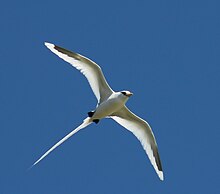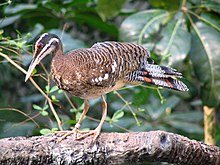Eurypygimorphae
Appearance
(Redirected fromPhaethontimorphae)
| Eurypygimorphae Temporal range:PossibleMaastrichtianrecord
| |
|---|---|

| |

| |
| Top:white-tailed tropicbird(Phaethontiformes) Bottom:sunbittern(Eurypygiformes) | |
| Scientific classification | |
| Domain: | Eukaryota |
| Kingdom: | Animalia |
| Phylum: | Chordata |
| Class: | Aves |
| Clade: | Phaethoquornithes |
| Clade: | Eurypygimorphae Fürbringer, 1888 |
| Orders | |
EurypygimorphaeorPhaethontimorphaeis acladeof birds that contains the ordersPhaethontiformes(tropicbirds) andEurypygiformes(kaguandsunbittern) recovered by genome analysis.[2]The relationship was first identified in 2013 based on their nuclear genes.[3]Historically these birds were placed at different parts of the tree, with tropicbirds inPelecaniformesand the kagu and sunbittern inGruiformes.Some genetic analyses have placed the eurypygimorph taxa in the controversial and obsolete cladeMetaves,with uncertain placement within that group.[4][5]More recent molecular studies support their grouping together in Eurypygimorphae, which is usually recovered as the sister taxon toAequornitheswithinArdeae.[2][6][7]
References[edit]
- ^Mayr, G.; De Pietri, V. L.; Love, L.; Mannering, A.; Crouch, E.; Reid, C.; Scofield, R. P. (2023)."Partial skeleton from the Paleocene of New Zealand illuminates the early evolutionary history of the Phaethontiformes (tropicbirds)".Alcheringa: An Australasian Journal of Palaeontology.47(3): 315–326.Bibcode:2023Alch...47..315M.doi:10.1080/03115518.2023.2246528.
- ^abJarvis, E.D.; et al. (2014)."Whole-genome analyses resolve early branches in the tree of life of modern birds".Science.346(6215): 1320–1331.Bibcode:2014Sci...346.1320J.doi:10.1126/science.1253451.PMC4405904.PMID25504713.
- ^Yuri, Tamaki; Kimball, Rebecca; Harshman, John; et al. (2013)."Parsimony and Model-Based Analyses of Indels in Avian Nuclear Genes Reveal Congruent and Incongruent Phylogenetic Signals".Biology.2(1): 419–444.doi:10.3390/biology2010419.PMC4009869.PMID24832669.
- ^Ericson, P. G.P; Anderson, C. L; Britton, T.; Elzanowski, A.; Johansson, U. S; Kallersjo, M.; Ohlson, J. I; Parsons, T. J; Zuccon, D.; Mayr, G. (2006)."Diversification of Neoaves: integration of molecular sequence data and fossils".Biology Letters.2(4): 543–547.doi:10.1098/rsbl.2006.0523.PMC1834003.PMID17148284.
- ^Hackett, S. J.; Kimball, R. T.; Reddy, S.; et al. (2008)."A Phylogenomic Study of Birds Reveals Their Evolutionary History"(PDF).Science.320(5884): 1763–1768.Bibcode:2008Sci...320.1763H.doi:10.1126/science.1157704.PMID18583609.S2CID6472805.
- ^Prum, R.O.et al.(2015)A comprehensive phylogeny of birds (Aves) using targeted next-generation DNA sequencing.Nature 526, 569–573.
- ^Suh, Alexander (2016)."The phylogenomic forest of bird trees contains a hard polytomy at the root of Neoaves".Zoologica Scripta.45:50–62.doi:10.1111/zsc.12213.ISSN0300-3256.
